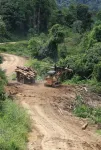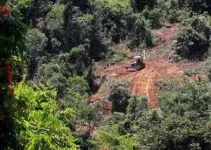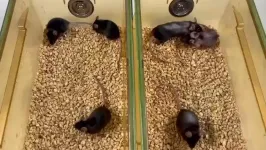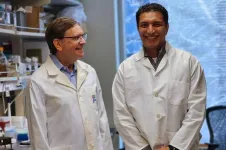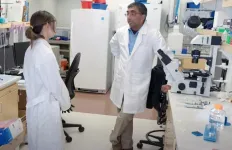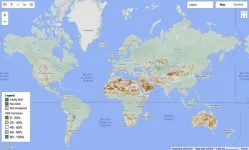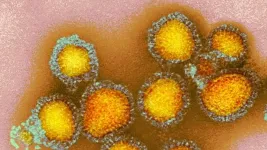(Press-News.org) Researchers have analysed data from 127 studies to reveal ‘thresholds’ for when logged rainforests lose the ability to sustain themselves.
The results could widen the scope of which forests are considered ‘worth’ conserving, but also show how much logging degrades forests beyond the point of no return.
The first-of-its-kind study, led by researchers from the Department of Life Sciences at Imperial College London with collaborators from around the world, is published today in Nature. The team looked at data from 127 plant and animal surveys covering more than 10 years in the same site in Sabah, Malaysia.
The site, named the Stability of Altered Forest Ecosystems (SAFE) Project, includes a full gradient of landscapes, including unlogged primary forests, selectively logged forests, protected riverside ‘buffer’ forests, and forests converted into oil palm plantations that represent 99% of forest removal.
While no level of forest degradation through logging was too low to have an impact on the ecosystem, the results showed that forests that had lost less than 29% of ‘biomass’ (total weight of organic matter) retained relatively high biodiversity and ecological value, and, if left alone, were likely to recover.
Preventing extinction
Above 68% biomass removal, however, many types of plants and animals formed communities that were effectively ‘scrambled’ by extinctions and invasive species. In these areas, serious proactive conservation would be needed to maintain biodiversity. Beyond this, the forests rapidly lost the ability to sustain themselves – to act as complete, functioning ecosystems.
Lead researcher Professor Robert Ewers, from the Department of Life Sciences at Imperial College London, said: “There has been a tendency in conservation to think of pristine forests as the only ones worth investing in – that logged forests were not worth looking at.
“What we’ve shown is that the potential ‘conservation estate’ is much larger than we thought, and while pristine forests are shrinking worldwide, this doesn’t mean all hope is lost, and there are other forests we can protect to preserve biodiversity.”
Co-author Dr Will Pearse, from the Department of Life Sciences at Imperial College London, said: “Pristine forests will always be the ideal, but there shouldn’t be a binary view of what’s worth preserving and what’s not. Some degree of logging may always be necessary, and while these forests are not the same as pristine ones, at certain thresholds they can still sustain themselves as functioning ecosystems.”
While the exact figures for forest destruction thresholds may vary across different environments, the study shows these can be found, with the right data.
Professor Ewers added: “A study like this has never been done, where so much data across landscapes, species and time have been collected together to determine critical thresholds. We now have a framework for assessing where these change points might be in other ecosystems.
“This is hopeful for conservation, giving us the tools to plot a course out of the extinction crisis more quickly.”
Nature worth preserving
Governments and policymakers in different countries use various measures to assess the likelihood of logging causing serious harm to local ecosystems. However, these can be imprecise as there isn’t a universal definition for which environments can be classified as forests.
Every environment is different, but the researchers think their results should be broadly applicable across the tropical rainforests of South-East Asia.
The Malaysian SAFE Project surveys counted the occurrences of 590 plants (including grasses, herbs, and woody trees), 88 mammals (including bats), 161 birds, 9 reptiles, 42 amphibians, 26 fish, and 635 invertebrates (including 263 beetles, 199 moths and butterflies, 130 ants, and 33 spiders), noting the impacts on each of the extent of logging damage.
Co-author Dr David Orme, from the Department of Life Sciences at Imperial College London, said: "Of course, we’ve known about the impacts of logging on biodiversity for a long time, but it's has been hard to pin down when that damage starts to bite. That’s partly because earlier studies have tended to look at different taxa, such as trees or birds, but here we have been able to include much wider data from across the tree of life.”
Dr Pearse added: “Hundreds of person-hours have gone into getting this result, but it goes to show it was worth it. There’s been a self-sustaining myth that certain species and organisms would only be found in pristine forests, so nobody looked for them in logged forests. But now we have looked, we have found a lot of these ‘trashed’ forests host a surprising amount of biodiversity.”
Co-author Dr Cristina Banks-Leite, from the Department of Life Sciences at Imperial College London, said: “Ecological thresholds are great tools that can be easily applied in conservation and management. For instance, thresholds found elsewhere have been used for deciding how much area needs to be reforested or preserved.
“The thresholds we identified in our study can also point to where restoration projects would get the best return to investment – changes in biodiversity are faster below 30% and above 70% biomass loss, which suggests that any improvement on habitat in these areas would lead to dramatic changes in biodiversity.”
Virtual ecosystem
The team are now constructing a ‘Virtual Ecosystem’ that can track the birth, growth, reproduction and death of organisms within a changing ecosystem, and are planning to use the data from this study to generate a virtual model of a Bornean rainforest.
This will allow researchers to address ecological questions that cannot be answered through field observations, such as how to optimize the ecological recovery of degraded tropical forests.
END
Logged forests can still have ecological value – if not pushed too far
2024-07-17
ELSE PRESS RELEASES FROM THIS DATE:
Exoplanet caught in ‘hairpin turn’ signals how high-mass gas giants form
2024-07-17
UNIVERSITY PARK, Pa. — Astronomers have discovered a planet that has the most oblong orbit ever found among transiting planets. The exoplanet’s extreme circuit — which looks closer to a cucumber than a circle — follows one of the most drastically stretched-out orbits of all known exoplanets, planets that orbit stars outside our solar system. It is also orbiting its star backwards, lending insight into the mystery of how close-in massive gas planets, known as hot Jupiters, form, stabilize and evolve over time.
The research, led by Penn State scientists, was published today (July 17) in ...
Switching off inflammatory protein leads to longer, healthier lifespans in mice
2024-07-17
Scientists at the Medical Research Council Laboratory of Medical Science and Imperial College London have discovered that ‘switching off’ a protein called IL-11 can significantly increase the healthy lifespan of mice by almost 25%.
The scientists, working with colleagues at Duke-NUS Medical School in Singapore, tested the effects of IL-11 by creating mice that had the gene producing IL-11 (interleukin 11) deleted. This extended the lives of the mice by over 20% on average.
They also treated 75-week-old mice – equivalent to the age of about 55 years in humans – with an ...
New gene therapy for muscular dystrophy offers hope
2024-07-17
A new gene therapy treatment for Duchenne muscular dystrophy shows promise of not only arresting the decline of the muscles of those affected by this inherited genetic disease, but perhaps, in the future, repairing those muscles.
The UW Medicine-led research focuses on delivering a series of protein packets inside shuttle vectors to replace the defective DMD gene within the muscles. The added genetic code will then start producing dystrophin, the protein lacking in patients with muscular dystrophy.
Currently, there is no cure for the disease ...
Scientists bridge the 'valley of death' for carbon capture technologies
2024-07-17
A major obstacle for net zero technologies in combatting climate change is bridging the gap between fundamental research and its application in the real world.
This gap, sometimes referred to as ‘the valley of death’, is common in the field of carbon capture, where novel materials are used to remove carbon dioxide from flue gasses produced by industrial processes. This prevents carbon from entering the atmosphere, helping to mitigate the effects of climate change.
Chemists have proposed and ...
Genome recording makes living cells their own historians
2024-07-17
Genomes can now be entrusted to store information about a variety of transient biological events inside of living cells, as they happen, like a flight recorder collecting data from an aircraft.
“Our method, which goes by the acronym ENGRAM, aims to turn cells into their own historians,” said Dr. Jay Shendure, a professor of genome sciences at the University of Washington School of Medicine and scientific director of the Brotman Baty Institute for Precision Medicine. Shendure led the effort, together with Wei Chen, a former graduate student, and Junhong Choi, a former postdoctoral fellow. Junhong ...
USC Schaeffer Institute launches new initiative to improve public policy through behavioral science
2024-07-17
The USC Schaeffer Institute for Public Policy & Government Service announced a new initiative today that leverages behavioral science to create more effective public policy.
The Behavioral Science & Policy Initiative at the USC Schaeffer Institute will conduct research to understand people’s beliefs and behaviors to create policies and communication that better fit people’s needs. The initiative will focus on policy topics such as climate change, health, and food insecurity.
“We want to help policymakers make a difference,” said Wändi Bruine de Bruin, the initiative’s ...
Groundwater is key to protecting global ecosystems
2024-07-17
(Santa Barbara, Calif.) — Where hidden water tables meet the Earth’s surface, life can thrive even in the driest locations. Offering refuge during times of drought, shallow groundwater aquifers act like water savings accounts that can support ecosystems with the moisture required to survive, even as precipitation dwindles. As climate change and human water use rapidly deplete groundwater levels around the world, scientists and policy makers need better data for where these groundwater-dependent ecosystems exist.
Now, a new study maps ...
A new approach to accelerate the discovery of quantum materials
2024-07-17
– By Michael Matz
Researchers at the Department of Energy’s Lawrence Berkeley National Laboratory (Berkeley Lab) and several collaborating institutions have successfully demonstrated an innovative approach to find breakthrough materials for quantum applications. The approach uses rapid computing methods to predict the properties of hundreds of materials, identifying short lists of the most promising ones. Then, precise fabrication methods are used to make the short-list materials and further ...
Influenza viruses can use two ways to infect cells
2024-07-17
Most influenza viruses enter human or animal cells through specific pathways on the cells’ surface. Researchers at the University of Zurich have now discovered that certain human flu viruses and avian flu viruses can also use a second entry pathway, a protein complex of the immune system, to infect cells. This ability helps the viruses infect different species – and potentially jump between animals and humans.
The majority of type A influenza viruses circulating in birds and pigs aren’t normally a health ...
Engineering resilience: Advanced FEM enhances earthquake impact assessment
2024-07-17
In a significant advancement for geotechnical engineering, a refined space-time finite element method (v-ST/FEM) has been introduced to tackle the complex dynamics of soil-structure interaction during seismic events. This new approach allows for more accurate simulations of the response of earth structures to earthquake vibrations, marking a crucial step in improving infrastructure resilience against natural disasters.
Designing structures like dams, tunnels, and embankments to withstand transient loads from sources such as earthquakes, high-speed trains, and explosions requires robust dynamic soil-structure interaction (SSI) analysis. Traditional methods often fall short in handling ...
